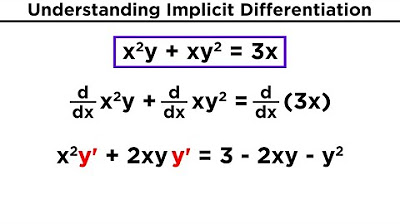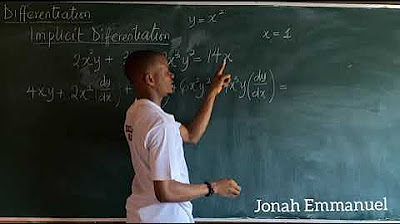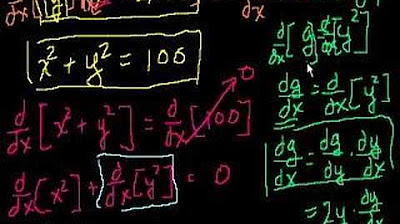Implicit Differentiation
TLDRProfessor Manny's video script provides an insightful exploration into the concept of implicit differentiation, a method used to find derivatives of equations that are not explicitly in terms of x. The script begins with a basic example of differentiating an equation with respect to x, highlighting the use of the chain rule when dealing with variables other than x. It then delves into implicit differentiation, emphasizing the importance of treating y as a function and applying the chain rule accordingly. The video offers two examples: differentiating the equation of a circle and a more complex equation involving x and y. Each example demonstrates the process of taking derivatives implicitly, showing how to isolate and solve for dy/dx. The key takeaway is that when differentiating with respect to x, treat x normally but use the chain rule for y, factor out dy/dx when necessary, and simplify the expression. The script encourages practice to master the technique, and ends with a call to action for viewers to like and subscribe for more educational content.
Takeaways
- 📚 Implicit differentiation is used when you can't express y in terms of x directly.
- 🔑 The chain rule is crucial in implicit differentiation, especially when dealing with y as a function of x.
- 📈 When differentiating with respect to x, if the expression is just x, the derivative is straightforward.
- 📉 If the expression involves y (a function of x), use the chain rule and multiply by dy/dx.
- 🔍 In implicit differentiation, you take the derivative of both sides of the equation with respect to x.
- 🧩 For terms involving both x and y, use the product rule to find their derivatives.
- 🌀 Isolate and factor out dy/dx terms to simplify the resulting equation.
- ⚖️ The goal is to express dy/dx in terms of x and y, without explicitly solving for y.
- 🔢 Practice is key to mastering implicit differentiation, as it can be a complex concept.
- 📐 Examples provided in the script demonstrate the process of differentiating equations like x^2 + y^2 = 25 and x^2 + 3xy = 5y^2.
- 📝 Implicit differentiation is particularly useful when the equation does not easily allow for explicit expression of y in terms of x.
Q & A
What is implicit differentiation?
-Implicit differentiation is a method used to find the derivative of an equation when it is not explicitly expressed in terms of one variable. It involves differentiating both sides of an equation with respect to a variable, typically 'x', and then solving for the derivative of the function 'y' with respect to 'x'.
Why is the chain rule used in implicit differentiation?
-The chain rule is used in implicit differentiation because when differentiating a term that involves 'y', which is a function of 'x', we need to account for the rate of change of 'y' with respect to 'x'. This is done by multiplying the derivative of the term inside by 'dy/dx'.
How do you differentiate the term '8x + 2' with respect to 'x' using implicit differentiation?
-In implicit differentiation, you would treat '8x + 2' as 'y', which is a function of 'x'. The derivative would then be '4y^3 * dy/dx' for 'y^4', and '8 * dy/dx' for '8x', since the derivative of 'x' with respect to 'x' is '1'.
What is the derivative of x^2 + y^2 = 25 with respect to x using implicit differentiation?
-The derivative is found by differentiating both sides with respect to 'x'. This gives '2x + 2y * dy/dx = 0'. After rearranging, we get 'dy/dx = -x/y'.
In the equation x^2 + 3xy = 5y^2, how do you handle the term '3xy' when differentiating with respect to x?
-The term '3xy' involves both 'x' and 'y', so you use the product rule. The derivative of '3xy' with respect to 'x' is '3y + 3x * dy/dx'.
What is the final form of the derivative for the equation x^2 + 3xy = 5y^2 after using implicit differentiation?
-After rearranging and factoring out 'dy/dx', the final form of the derivative is '(2x + 3y) / (10y - 3x)'.
What is the key to solving problems using implicit differentiation?
-The key is to differentiate with respect to 'x'. For terms involving only 'x', use the standard derivative. For terms involving 'y', apply the chain rule and multiply by 'dy/dx'. If there are multiple 'dy/dx' terms, get them on the same side, factor them out, and then simplify the equation.
Why might you not solve for 'y' explicitly in an implicit differentiation problem?
-You might not solve for 'y' explicitly because it may not be possible to express 'y' in terms of 'x' in a simple or useful way. Implicit differentiation allows you to find the derivative of 'y' with respect to 'x' without needing to isolate 'y'.
How does practice help in understanding implicit differentiation?
-Practice helps in understanding implicit differentiation by reinforcing the method's steps and allowing you to become familiar with the various forms and structures of equations that can be differentiated implicitly.
What is the role of 'dy/dx' in implicit differentiation?
-'dy/dx' represents the derivative of 'y' with respect to 'x'. It is used to denote the rate of change of the function 'y' as 'x' changes, which is crucial when differentiating terms involving 'y'.
Can implicit differentiation be used for any equation involving 'y' as a function of 'x'?
-Implicit differentiation can be used for any equation where 'y' is a function of 'x', especially when it is not straightforward or possible to express 'y' explicitly in terms of 'x'.
What is the general approach to solving an equation using implicit differentiation?
-The general approach involves differentiating both sides of the given equation with respect to 'x', treating 'y' as a function of 'x', and then solving for 'dy/dx', which represents the derivative of 'y' with respect to 'x'.
Outlines
📚 Introduction to Implicit Differentiation
Professor Manny introduces the concept of implicit differentiation, explaining how it differs from explicit differentiation. He uses an example involving a function of 'y' in terms of 'x' and demonstrates the need to apply the chain rule when differentiating with respect to 'x'. The key insight is that while the derivative of 'x' is straightforward, the derivative of 'y' requires multiplying by the derivative of 'y' with respect to 'x', denoted as dy/dx. The professor then illustrates this with a simple example of a circle's equation, x^2 + y^2 = 25, and shows how to rearrange terms to solve for dy/dx.
🔍 Applying Implicit Differentiation to a More Complex Problem
The professor moves on to a more complex example, x^2 + 3xy = 5y^2, to further illustrate the process of implicit differentiation. He explains the use of the product rule for terms involving both 'x' and 'y', and emphasizes the strategy of gathering all dy/dx terms on one side to facilitate factorization. The goal is to isolate and solve for dy/dx. The professor concludes by reminding viewers of the importance of practice in mastering implicit differentiation and encourages them to like and subscribe for more educational content.
Mindmap
Keywords
💡Implicit Differentiation
💡Chain Rule
💡Derivative
💡Product Rule
💡dy/dx
💡Variable
💡Function
💡Constant
💡Simplify
💡Practice
💡Composite Functions
Highlights
Introduction to implicit differentiation and its derivation process.
Explanation of using the chain rule when differentiating with respect to x.
Differentiating an equation where y is not explicitly in terms of x.
The concept of treating y as a function and using dy/dx in the differentiation process.
Demonstration of implicit differentiation on a simple equation: x^2 + y^2 = 25.
Technique to isolate dy/dx and simplify the derivative expression.
Approach to a more complex equation: x^2 + 3xy = 5y^2.
Use of the product rule in implicit differentiation for terms involving both x and y.
Strategy to get all dy/dx terms on the same side of the equation.
Factoring out dy/dx to simplify the equation and solve for it.
Final step of dividing by the coefficient to isolate dy/dx.
Emphasis on the importance of practice to master implicit differentiation.
Encouragement for viewers to like and subscribe for more educational content.
Summary of the key steps in implicit differentiation: normal differentiation for x, and chain rule application for y.
Explanation of how to handle multiple dy/dx terms in an equation.
The process of moving towards a final simplified form of the derivative.
Advice on how to approach and solve implicit differentiation problems effectively.
The significance of understanding the underlying principles of implicit differentiation for problem-solving.
Transcripts
5.0 / 5 (0 votes)
Thanks for rating:





